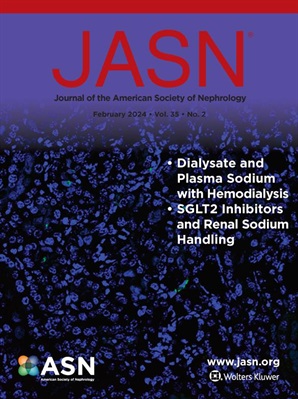遗传变异和超滤与腹膜透析:一项全基因组关联研究。
IF 10.3
1区 医学
Q1 UROLOGY & NEPHROLOGY
引用次数: 0
摘要
背景:腹膜透析(PD)患者的超滤量存在很大的个人差异,其中大部分不能用人口统计学和临床差异来解释。在此,我们验证了常见遗传变异与腹膜超滤相关的假设,并探索了遗传研究确定的一种机制途径。方法:我们对遗传率进行了估计,并进行了全基因组和基因研究,调整了腹膜溶质转移率(PSTR),以测试遗传变异与2723名国际Bio-PD研究参与者在PD开始时进行的腹膜平衡测试(PET)超滤的相关性。我们采用PD小鼠模型,研究PTGES基因与腹膜超滤相关的机制基础。结果在PD开始后的中位时间为61天(IQR 38-118),中位4小时超滤量为250 mL (IQR 25-465)。估计腹膜超滤的遗传率为50% (p=0.001)。在使用TRACTOR软件的单核苷酸变异(SNV)多祖先GWAS中,一个SNV在欧洲本地血统的参与者(rs72631501, CRK内含子,p=2.6 × 10-8)和一个南亚本地血统的参与者(rs1416265,基因间,p=4.2 × 10-8)中达到全基因组显著性。基因分析显示,在欧洲地层中,21个基因的错误发现率(FDRs) <0.10,显著相关,特别是PTGES (FDR=0.053), SLC24A3 (FDR=0.0003)和CRK (FDR=0.04)。在4个祖先地层的荟萃分析中,SLC24A3仍然显著(FDR=0.03)。使用scRNAseq, PTGES定位于腹膜脂肪细胞。在小鼠PD模型中,PTGES的药理调节改变了透析液前列腺素E2 (PGE2)水平,改变了脂肪细胞体积、腹膜小溶质转移率和超滤体积。结论常见的遗传变异占了腹膜超滤变异性的很大一部分,与包括CRK、PTGES和SLC24A3在内的21个基因有潜在的关联。功能研究证实了pges /PGE2在调节腹膜超滤中的潜在作用。本文章由计算机程序翻译,如有差异,请以英文原文为准。
Genetic Variation and Ultrafiltration with Peritoneal Dialysis: A Genome-Wide Association Study.
BACKGROUND
There is a large person-to-person variability in ultrafiltration volume with peritoneal dialysis (PD), most of which cannot be accounted for by demographic and clinical differences. Herein we tested the hypothesis that common genetic variants are associated with peritoneal ultrafiltration and explored one mechanistic pathway identified by genetic studies.
METHODS
We generated estimates of heritability and undertook genome-wide and gene-wise studies, adjusted for peritoneal solute transfer rate (PSTR), to test associations of genetic variation with ultrafiltration on peritoneal equilibration test (PET) done at PD initiation in 2723 participants in the international Bio-PD study. We used a mouse model of PD to study the mechanistic basis for the association of PTGES gene with peritoneal ultrafiltration.
RESULTS
PET was done at a median of 61 days (IQR 38-118) from PD start with a median 4-hour ultrafiltration volume of 250 mL (IQR 25-465). The heritability of peritoneal ultrafiltration was estimated to be 50% (p=0.001). In single nucleotide variant (SNV)-wise multi-ancestry GWAS using TRACTOR software, one SNV reached genome-wide significance in participants with European local ancestry (rs72631501, CRK intron, p=2.6x10-8) and one in participants with South Asian local ancestry (rs1416265, intergenic, p=4.2x10-8). Gene-wise analyses showed significant association of 21 genes at false discovery rates (FDRs) <0.10 in the European strata, notably PTGES (FDR=0.053), SLC24A3 (FDR=0.0003) and CRK (FDR=0.04). SLC24A3 remained significant (FDR=0.03) in meta-analysis of the four ancestry strata. Using scRNAseq, PTGES localized in peritoneal adipocytes. In a mouse PD model, pharmacological modulation of PTGES altered dialysate prostaglandin E2 (PGE2) levels with changes in adipocyte volume, peritoneal small solute transfer rate, and ultrafiltration volume.
CONCLUSIONS
Common genetic variants accounted for a substantial proportion of the variability in peritoneal ultrafiltration with potential associations with 21 genes, including CRK, PTGES and SLC24A3. Functional studies substantiated a potential role for PTGES/PGE2 in regulating peritoneal ultrafiltration.
求助全文
通过发布文献求助,成功后即可免费获取论文全文。
去求助
来源期刊
CiteScore
22.40
自引率
2.90%
发文量
492
审稿时长
3-8 weeks
期刊介绍:
The Journal of the American Society of Nephrology (JASN) stands as the preeminent kidney journal globally, offering an exceptional synthesis of cutting-edge basic research, clinical epidemiology, meta-analysis, and relevant editorial content. Representing a comprehensive resource, JASN encompasses clinical research, editorials distilling key findings, perspectives, and timely reviews.
Editorials are skillfully crafted to elucidate the essential insights of the parent article, while JASN actively encourages the submission of Letters to the Editor discussing recently published articles. The reviews featured in JASN are consistently erudite and comprehensive, providing thorough coverage of respective fields. Since its inception in July 1990, JASN has been a monthly publication.
JASN publishes original research reports and editorial content across a spectrum of basic and clinical science relevant to the broad discipline of nephrology. Topics covered include renal cell biology, developmental biology of the kidney, genetics of kidney disease, cell and transport physiology, hemodynamics and vascular regulation, mechanisms of blood pressure regulation, renal immunology, kidney pathology, pathophysiology of kidney diseases, nephrolithiasis, clinical nephrology (including dialysis and transplantation), and hypertension. Furthermore, articles addressing healthcare policy and care delivery issues relevant to nephrology are warmly welcomed.

 求助内容:
求助内容: 应助结果提醒方式:
应助结果提醒方式:


